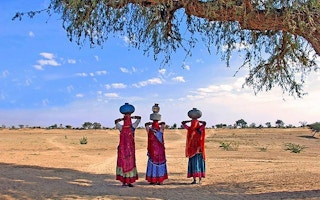Thario Halepoto village is located in the Thar desert in south-eastern Pakistan, around 400 kilometres east of the port city of Karachi. You can hear the scream of peafowl and bells sounding around the necks of grazing goats and cows. Women wearing colourful clothes carrying water pitchers on their head walk between the sand dunes.
Around 1,000 households live in the village, the majority of them part of the Halepoto clan. But life here is about to change, with the arrival of Chinese and Pakistan joint venture to excavate the massive coal deposits that lie beneath the sand and build coal fired power stations to meet Pakistan’s energy demands.
Mehmood Halepoto’s family has lived in this village for centuries. Like other residents, Halepoto is a herder who ploughs the fields when it rains. In 1990 officials came looking for coal, and found huge deposits under the village.
The Thar desert in Sindh province contains 175 billion tonnes of lignite coal – one of the largest untapped coal deposits in the world. It is also one of the most populated deserts in the world – home to world heritage sites and endangered species.
Most of the 1.6 million people who live in the Thar desert region live in poverty and are highly vulnerable to extreme weather events. Twenty five per cent of people live within the proposed coal development area. They thought they would benefit, but that has not been the case.
“We were happy, as people told us we would be rich, but now, this has turned into a nightmare and the black gold has become a black snake that is displacing us from our ancestral land,” he told thethirdpole.net.
It was only in 2015 that work began on the fields, when the Thar coal project was included as part of a string of energy and infrastructure deals signed under the USD 46 billion China-Pakistan Economic Corridor (CPEC). These agreements included eight coal-fired power plants and a 3,000-kilometre network of roads, railways and pipelines to transport oil and gas from Gwadar Port on the Arabian sea to Kashgar, in the northwestern Chinese province of Xinjiang.
“
We were happy, as people told us we would be rich, but now, this has turned into a nightmare and the black gold has become a black snake that is displacing us from our ancestral land.
Mehmood Halepoto, villager, Thar desert, Pakistan
In December 2015, China approved a USD 1.2 billion investment for surface mining of Thar coal and the establishment of 660 MW power projects. The deposits are divided into 12 blocks, each containing 2 billion tonnes of coal.
In the first phase the Sindh provincial government has allocated block II to Sindh Engro Coal Mining Company (SECMC) to excavate 1.57 billion tonnes of coal and build a 660 megawatt power plant. The plant is expected to send power to the Pakistani national grid by June 2019 and will later be expanded to produce 1,320 MW of power.
A state-owned Chinese company, the China Machinery & Engineering Corporation (CMEC), is providing the machinery and technical support for the excavation of coal, and building and running the power plant. The local company will provide human resources, management and be responsible for the distribution of power.
SECMC say the project has created 200 technical jobs and 1,600 menial positions. But locals have been protesting that the company has not even given them the menial jobs. Around 300 Chinese, including the engineers, miners and experts are also working on the site.
Local fears
The Chinese team have started excavating the first pit. In the first phase SECMC will relocate five villages, which are located in block II, including Thario Halepoto village.
SECMC has started paying villagers for their homes and agricultural land. SECMC’s chief executive officer, Shamsuddin Ahmed Shaikh, claims that his company will do all they can to help the villagers.
“We will construct model towns with all basic facilities including schools, healthcare, drinking water and filter plants and also allocate land for livestock grazing,” he told thethirdpole.net
He said that the company is paying villagers above market prices for their land – PKR 185,000 (USD 1,900) per acre. However locals say this price does not take into account its high environmental value and they do not want to be relocated to the new towns, the exact location of which is yet to be decided.
“We [our families] lived in this village for centuries, we spent our childhood here and our forefathers are buried here; to leave all this is very difficult,” said Muhammad Hassan Halepoto, a resident of the Thario Halepoto.
“We have dozens of trees on each acre of land. We feed our livestock from these trees even during droughts and also when it rains we plough our lands and get a huge amount from the crops. These lands are our permanent source of livelihood,” said one villager.
The villagers will also lose grazing lands to the coal project. The Thar desert is home to 7 million cows, goats, sheep and camel and provides more than 60% of the milk, meat and leather requirement of Sindh province.
Villagers fear that the project will be an environmental disaster for the desert. The company will cut thousands of indigenous trees to make way for the mining and construction of roads, destroying the local ecology.
This story was published with permission from The Third Pole. Read the full story.










